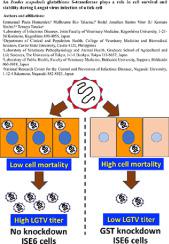Acta Tropica ( IF 2.1 ) Pub Date : 2020-11-24 , DOI: 10.1016/j.actatropica.2020.105763 Emmanuel Pacia Hernandez , Melbourne Rio Talactac , Rodel Jonathan Santos Vitor , Kentaro Yoshii , Tetsuya Tanaka

|
Ticks are important vectors of diseases affecting both humans and animals. To be an efficient vector, ticks have to survive infection by pathogens such as the Langat virus (LGTV). One method utilized by ticks is their complex antioxidant mechanism. Included in the vast antioxidant processes are several enzymes involved in redox homeostasis. The ubiquitous glutathione S-transferases (GSTs) belong to the antioxidant family of enzymes. In this study, we evaluated the role of a GST during LGTV infection.
ISE6 cells were infected with LGTV with a multiplicity of infection (MOI) of 0.01 and observed daily. The infection success was monitored via indirect immunofluorescent antibody test (IFAT) for LGTV for up to 4 days. The gene expression of IsGST1 was determined by real-time polymerase chain reaction (PCR) using IsGST1 gene–specific primers. Knockdown of the IsGST1 gene with subsequent LGTV infection was also performed. Afterward, ISE6 cell mortality and viability were checked daily until the fourth day. The virus titer from supernatants of IsGST1-knockdown cells was quantified using a focus-formation assay.
IFAT data showed that LGTV infects ISE6 cells in a time-dependent manner with increasing infection from day 0 to day 4. The IsGST1 genes showed an increasing expression until day 2 of infection, while decreased expression was observed from day 3 to day 4 post-infection. Knockdown of the IsGST1 resulted in increased mortality on the third day of infection, while the cell viability was also negatively affected by the knockdown of the IsGST1 genes from day 0 to day 4 post-infection. Knockdown of the IsGST1 genes also resulted in a decreased viral titer from the supernatants of the ISE6 cells infected with LGTV.
Based on the results, GSTs are possibly utilized both by cells and the virus for mutual survival and proliferation.
中文翻译:

的肩突硬蜱谷胱甘肽S转移酶起着蜱细胞系的兰加特病毒感染过程中细胞存活和活力的作用
壁虱是影响人类和动物疾病的重要媒介。为了成为有效的媒介,s必须在诸如兰加特病毒(LGTV)的病原体感染下存活下来。壁虱利用的一种方法是其复杂的抗氧化机理。广泛的抗氧化剂过程包括氧化还原稳态中涉及的几种酶。普遍存在的谷胱甘肽S-转移酶(GST)属于酶的抗氧化剂家族。在这项研究中,我们评估了GST在LGTV感染过程中的作用。
ISE6细胞用LGTV感染,感染复数(MOI)为0.01,每天观察一次。通过间接免疫荧光抗体测试(IFAT)对LGTV进行长达4天的感染成功监测。的基因表达IsGST1通过使用实时聚合酶链反应(PCR)测定IsGST1基因特异性引物。还对IsGST1基因进行了敲除,随后进行了LGTV感染。之后,每天检查ISE6细胞的死亡率和生存力,直到第四天为止。使用聚焦形成测定法对来自IsGST1-敲低细胞的上清液的病毒效价进行定量。
IFAT数据显示,LGTV以时间依赖性方式感染ISE6细胞,从感染后第0天到第4天感染量增加。IsGST1基因在感染后第2天显示出表达增加,而从感染后第3天到第4天观察到表达降低。感染。敲低的IsGST1导致感染的第三天死亡率增加,而细胞存活率也负被击倒影响IsGST1从第0天至基因后第4天感染。敲低IsGST1基因也导致感染LGTV的ISE6细胞上清液的病毒滴度降低。
根据结果,GSTs可能同时被细胞和病毒利用,以相互生存和增殖。











































 京公网安备 11010802027423号
京公网安备 11010802027423号